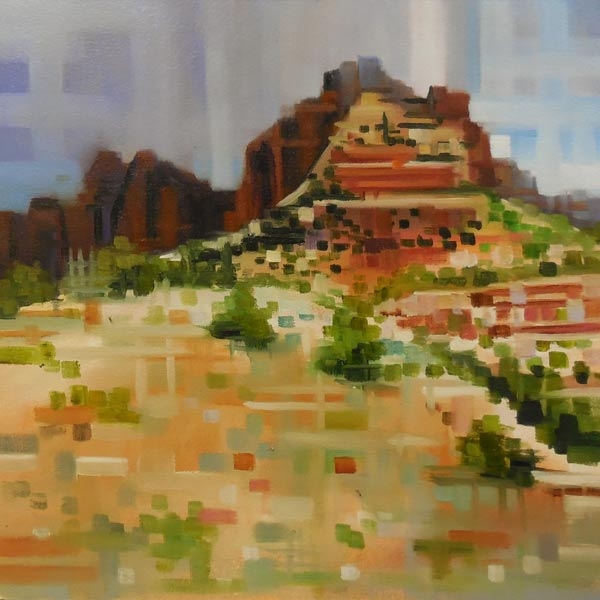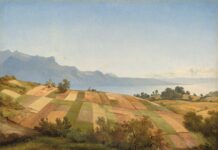
Utah artist Michelle Condrat suggests motion in her paintings through an unusual method.

“Bareback,” by Michelle Condrat, oil, 12 x 12 in.
About 70 percent of the way through her painting process, she examines the composition to see which areas need her unique touch. “I like to break up the edges and have the eye fill in the information,” says Condrat. “It works well in landscapes because it gives the painting a little bit of motion. And what I’m seeing out there actually has some motion to it. I want some kind of action and motion, because that’s how we see. Only still lifes are just sitting there. Trees have leaves that are moving.”

“Sunset in Zion,” by Michelle Condrat, oil, 18 x 18 in.
Condrat starts with a grisaille-like underpainting, usually burnt umber or burnt sienna, wiping away pigment for highlights and reinforcing the paint in shadow areas. She works from general shapes and general color to more detail. When the time is right, she starts looking for places to add the pixelated effect. “I don’t see the locations for it right away. It’s where I want the focal point or where I want something to go into the sky. I like to use it for highlights in the face, or in the landscape. It’s where you are drawn to. But I can also use it to fade the background in — have a shoulder in a portrait, for example, get completely lost into the background.”

“50 Shades of Red Rock,” by Michelle Condrat, oil, 12 x 16 in.
Her technique may seem like a pixelated view of the subject matter, but it did not emerge from the artist playing around in Photoshop. “I don’t manipulate in Photoshop at all,” says Condrat. “I just try to see the parts that I would want to pixelate and blow out the edges.” It began with studio pieces, but since it has become a normal part of her technique, Condrat can execute it en plein air with ease.

“Misty Morning,” by Michelle Condrat, oil, 12 x 16 in.
It’s not just a matter of “blowing out the curves.” Condrat also utilizes contrasting colors. “Every square, every stroke is consciously put down,” says the artist. “I may put in some crazy turquoise, maybe. I put it there because I want to draw attention there — I call it a spoiler color because you don’t expect it to be there.” How does she know which parts to blow out? “You just have to go with it, and you might have to bump it back and make a curve, go with the organic line you see in the landscape.”
Condrat says the red rock areas of Utah are well suited to her method, as the colors are striated and the lines can be blocky.

“Forever Young,” by Michelle Condrat, oil, 12 x 16 in.
Her style does make one thing simpler in her life: buying paintbrushes. “Every single one of my brushes is a bright,” she says with a laugh.





Love it — is that a Sienna Plein Air pochade & supply box?
yes, it sure is and I love it…shoulda ordered the large on tho..lol..it is so easy to cart around..so VERY well made and has endured my clumpsy falls. Ps it cleans up beautifuly, I use a good disposable palette paper under that mess..this is after a long painting spree and me being lazy 🙂
Speaking of dirty palettes-
I have seen many professional palettes
where the paint piles (laid out in the same position each time) have become mountains of dried paint upon whitch fresh paint is placed. Don’t crumbs of dried paint from these piles get onto the brush and into the painting?
What could the advantage be?